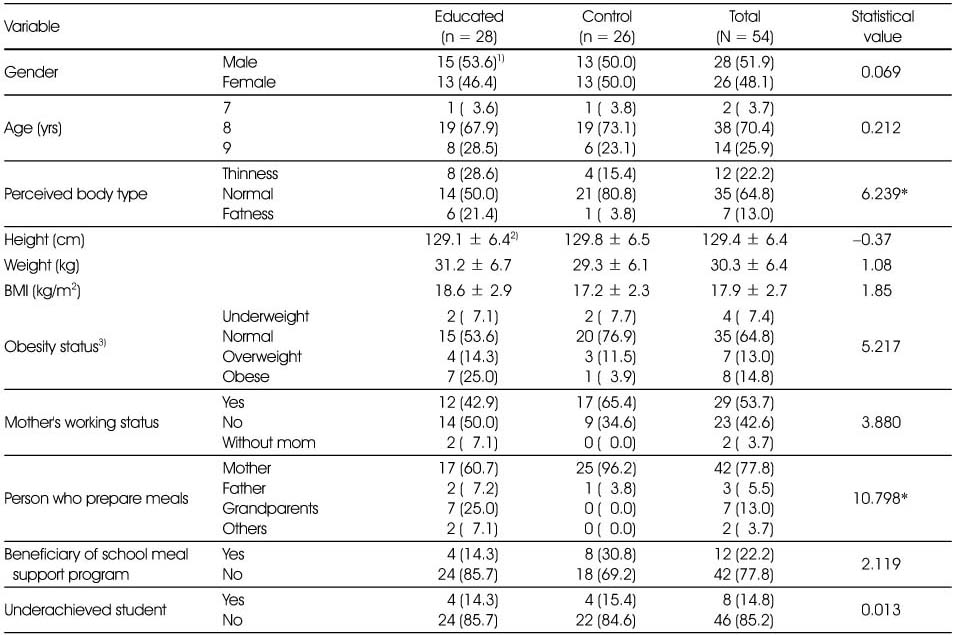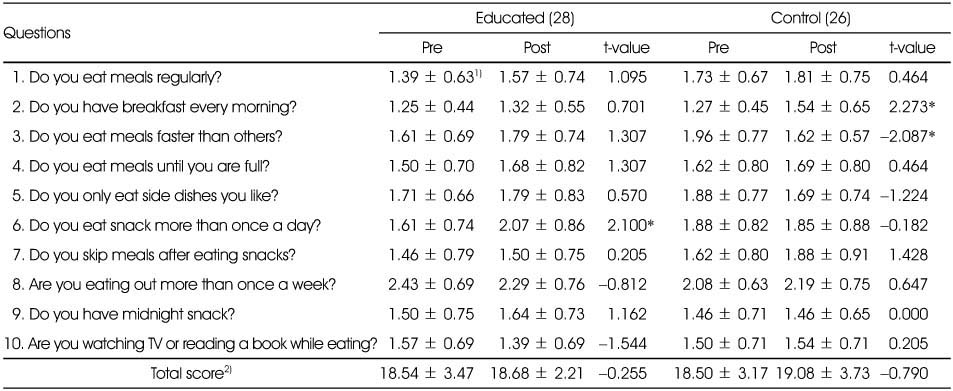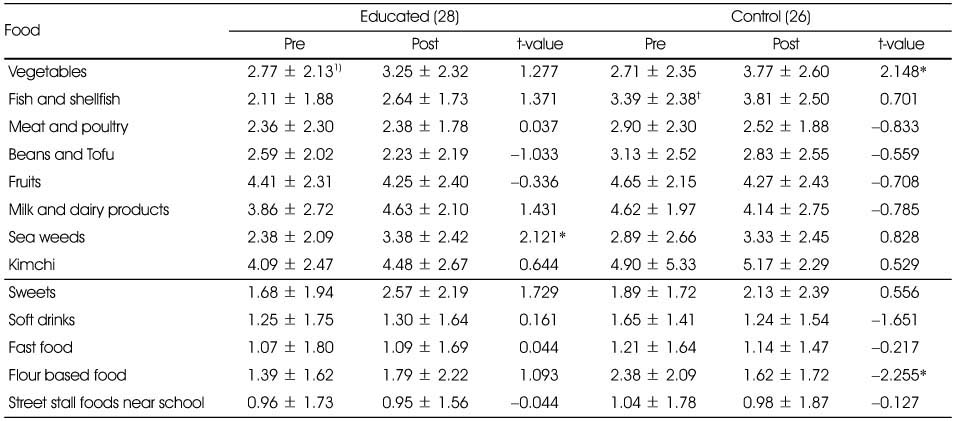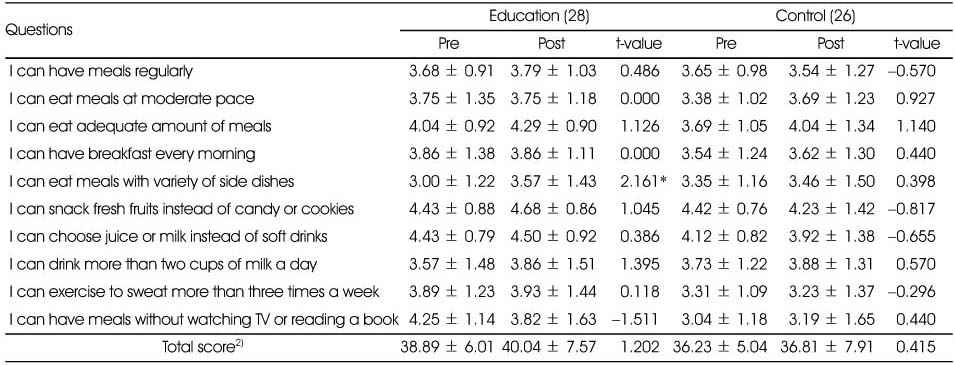References
1. Ahn Y, Ko SY, Kim KW. Evaluation of a nutrition education program for elementary school children. Korean J Community Nutr 2009. 14(3)266–276.
2. Bundy D. School health and nutrition: policy and programs. Food Nutr Bull 2005. 26(2)S186–S192.
3. Heo ES. Evaluation of problem and nutritional education status for children's nutrition, and the development of internet assisted nutritional education program for children's healthy dietary habit 2002. Changwon National University; Dissertation.
4. Hwang SN. Nutrition education for elementary school students step by step process 2008. Seoul Metropolitan Office of Education;
5. Hyon SM, Kim JW. Improvement of dietary attitudes of elementary students by nutrition labeling education. Korean J Community Nutr 2007. 12(2)168–177.
6. Jeong NY, Kim KW. Nutrition knowledge and eating behaviors of elementary school children in Seoul. Korean J Community Nutr 2009. 14(1)55–66.
7. Kim KA, Lee YK. The effect of nutrition education using animations on the nutrition knowledge, eating habits and food preferences of elementary school students. Korean J Community Nutr 2010. 15(1)50–60.
8. Kim SB, Choi HJ. Effects of nutrition education using food exchange system: changes in elementary students' nutrition knowledge, dietary attitude and nutrients intake. Korean J Community Nutr 2008. 13(6)922–933.
9. Koo JO, Lee JW, Choi YS, Kim JH, Lee JH. Nutrition throughout the life cycle 2006. Seoul: Hyoil Publishing Co.;
10. Korea Centers for Disease Control and Prevention. The Korean Pediatrics Society. Korean national growth charts 2007.
11. Kwon YK, Jang YA, Kim KW. Application of a practical nutrition education program (KHIDIKIDS) for the improvement of dietary attitudes and habits of elementary students. Korean J Nutr 2006. 39(8)808–816.
12. Lee JW, Lee HS, Chang NS, Kim JM. The relationship between nutrition knowledge scores and dietary behavior, dietary intakes and anthropometric parameters among primary school children participating in a nutrition education program. Korean J Nutr 2009. 42(4)338–349.
13. Lee JY, Lee SY. A comparative study on nutrition knowledge, eating behavior and nutrient intake for students at elementary schools with and without nutrition education program. J East Asian Soc Diet Life 2004. 14(6)561–570.
14. Lee OK, Chang SO, Park MJ. Comparison of nutrition knowledge, dietary attitude and dietary habit in elementary school children with and without nutrition education. J Korean Soc Food Sci Nutr 2008. 37(11)1427–1434.
15. Lee SY. A comparative study on nutrition knowledge, eating behavior and a nutrient intake for students in elementary schools with and without nutrition education problem 2003. Dongguk University; MS thesis.
16. Lee YJ, Kim GM, Chang KJ. The analysis of effect on nutrition education of elementary school children, Incheon. J Korean Diet Assoc 2000. 6(2)86–96.
17. Lee YM, Lee MJ, Kim SY. Effects of nutrition education through discretional activities in elementary school - Focused on improving nutrition knowledge and dietary habits in 4th-, 5th- and 6th-grade students. J Korean Diet Assoc 2005. 11(3)331–340.
18. Ministry for Health, Welfare and Family Affairs. Korea Centers for Disease Control and Prevention. 2008 National health statistics - The 4th Korea national health and nutrition examination survey 2009. Korea: Korea Centers for Disease Control and Prevention;
19. Oh YJ, Lee YM, Kim JH, Ahn HS, Kim JW, Park HR, Seo JS, Kim KW, Kwon OR, Park HK, Lee EJ, Sung HN. Interview survey of elementary school student's nutrition education and practice. Korean J Community Nutr 2008. 13(4)499–509.
20. Park A, Chang KJ. A study on elementary school dietitian's status and recognition of nutrition education in Incheon. Korean J Community Nutr 2004. 9(6)716–724.
21. Park HO, Kim EK, Chi KA, Kwak TK. Comparison of the nutrition knowledge, food habits and life styles of obese children and normal children in elementary school in Kyeong-gi province. Korean J Community Nutr 2000. 5(4)586–597.
22. Park YH, Kim HH, Shin KH, Shin EK, Bae IS, Lee YK. A survey on practice of nutrition education and perception for implementing nutrition education by nutrition teacher in elementary schools. Korean J Nutr 2006. 39(4)403–416.
23. Pearson N, Biddle SJ, Gorelt T. Family correlates of fruit and vegetable consumption in children and adolescents: a systemic review. Public Health Nutr 2009. 12(2)267–283.
24. Raulio S, Roos E, Prattala R. School and workplace meals promote healthy food habits. Public Health Nutr 2010. 13(6A)987–992.
25. Seo JS, Kim KW, Yoon EY, Bae HJ. Development of contents for nutrition education for nutritionally vulnerable groups. Report of the research grant supported by the Korea Food and Drug Administration 2006.
26. Shin EK, Lee HS, Lee YK. Effect of nutrition education program in obese children and their parents(I) - Focus on anthropometric values and serum biochemical index. Korean J Community Nutr 2004. 9(5)566–577.
27. Shin EK, Shin KH, Kim HH, Park YH, Bae IS, Lee YK. A survey on the needs of educators, learners and parents for implementing nutrition education by nutrition teachers in elementary schools. J Korean Diet Assoc 2006. 12(1)89–101.
28. Singhal N, Misra A, Shah P, Gulati S. Effect of controlled school-based multi-component model of nutrition and lifestyle intervention on behavior modification, anthropometry and metabolic risk profile of urban Asian Indian adolescents in North India. Eur J Clin Nutr 2010. 64(4)364–373.
29. Suh EN, Kim CK. Analysis of nutrition education for elementary schools based upon elementary school teachers within inner Seoul. Korean J Nutr 1998. 31(4)787–798.
30. Trahms CM. Nutrition in childhood. Nutrition throughout the life cycle 2000. Boston: McGraw-Hill;
31. Woo TJ, Her Es, Lee KH. Effect-evaluation of nutrition education textbook and teaching manual in elementary school. J Korean Diet Assoc 2006. 12(3)299–306.
32. Yon MY, Hyun TS. Evaluation of nutrition education program for obese children. Hum Ecol Res 2007. 11(2)143–151.
33. Yoon HS, Yang HL, Her ES. Effect of nutrition education program on nutrition knowledge, dietary diversity of elementary school children. Korean J Community Nutr 2000. 5(3)513–521.
34. Yu OK, Park SH, Cha YS. Eating habits, eating behaviors and nutrition knowledge of higher grade elementary school students in Jeonju area. Korean J Food Cult 2007. 22(6)665–672.
35. Yun HH. Effects of nutrition education on eating behavior, nutrition knowledge and nutrient intake by school mealservice. An empirical study on elementary school children in Chonbuk area 2004. Chonbuk University; MS thesis.






